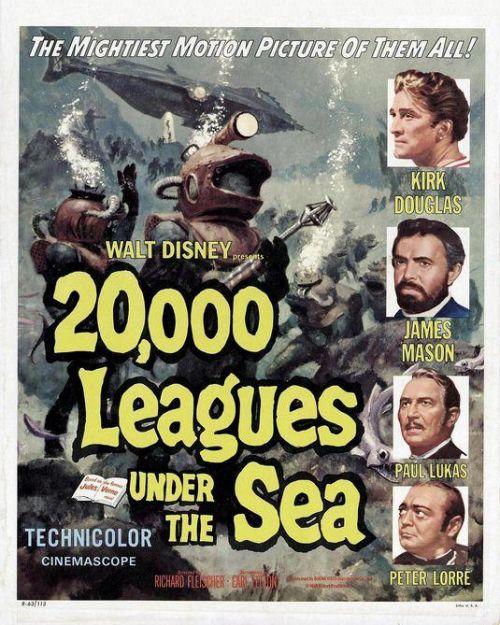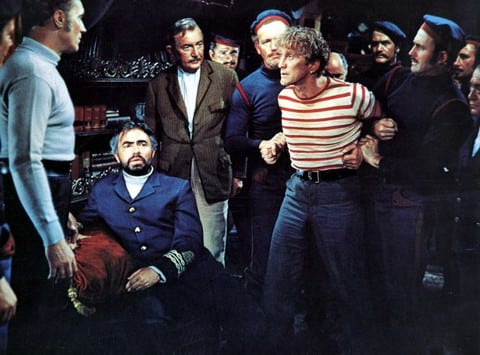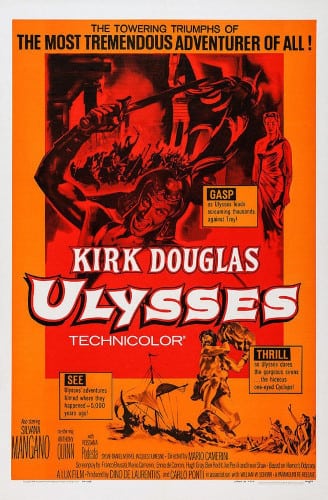20 000 Leagues Under the Sea (1954)
Directed by: Richard Fleischer
Written by: Earl Felton, Jules Verne
Starring: James Mason, Kirk Douglas, Paul Lukas, Peter Lorre
USA
AVAILABLE ON DVD
RUNNING TIME: 127 min
REVIEWED BY:Dr Lenera, Official HCF Critic
In 1868 rumours of a sea monster attacking ships in the Pacific Ocean have created apprehension and fear among sailors, disrupting shipping lanes. The U.S. government invites Professor Pierre M. Aronnax and his assistant, Conseil, to join an expedition to prove or disprove the monster’s existence. On board with them is harpooner Ned Land. After months of searching, they are sunk by the monster, which turns out to be a man-made “submerging boat” called the Nautilus and captured. Its Captain, Nemo, has been using it to sink war ships in an effort to curb war and save lives. Aronnax begins to befriend Nemo and help him in his scientific research, but all Ned thinks about is escaping, perhaps with some of that gold Nemo has locked away….
It’s a bit of a silly title really. A league is considered to be three nautical miles at sea, a nautical mile being about 1.15 miles. Therefore around 60,000 miles deep is absurdly deep, unless we’re talking about the distance they travelled under the surface of the sea. O well. The news that Jules Verne’s novel was getting another cinematic re-doing, after years of delays, inspired me to take another look at the original 1954 version of the story, though it’s not really the ‘original’ version as it had previously been filmed in 1916. By modern standards, the movie is a little slow and fairly low on action scenes, but it still holds up pretty well in most other respects, even with regard to most [if not quite all] of its special effects, while it has both philosophical complexity and psychological complexity of the kind you tend not to get in similar movies, at least of the time, which makes it very thought provoking. Its villain, or should I say anti-hero, is one of the screen’s most fascinating, at least in science fiction, though by contrast its supposed hero is astonishingly unsympathetic, which slightly unbalances the film but also creates an interesting dynamic. As long as you don’t expect nonstop thrills, you should still get quite a lot out of 20,000 Leagues Under The Sea.
Walt Disney had wanted to bring the book to the screen for over a decade, and considered doing it both as an animated movie and a partially animated movie a la Mary Poppins. Verne’s novel is virtually a travelogue for much of the time, so screenwriter Earl Felton added elements of the prison movie and borrowed the climax from Verne’s Facing The Flag, as well as updating some of Verne’s now outdated ideas. Charles Boyer was originally considered for the role of Professor Arronax, but had to turn down the role due to prior commitments, while Ralph Richardson almost played Captain Nemo. Underwater scenes were shot in the same Bahamas locale as the ones in the 1916 version, and had a crew of 400 people under the water at times. The film, otherwise filmed in New Guinea and at the Disney Studio, was the first Disney feature to use the new CinemaScope process, and there being only one CinemaScope camera available prevented multiple units from shooting at the same time, which contributed to the lengthy production schedule, along with Kirk Douglas’s request for a scene where he could sing and a new opening scene showing him with two ladies to fit in with his screen image as a boisterous, womanising tough guy. Then they decided to scrap the main action set piece – the battle with the giant squid – because it didn’t look right and reshoot it as a night time sequence set during a storm. The hugely expensive production managed to be a critical and commercial hit. Oddly enough there hasn’t been a cinema remake since, though two middling TV movies have appeared, and Disney’s 1979 The Black Hole was kind of a semi-remake.
As with some of the Disney cartoon features, we begin with having the novel opened and we begin to read it, though here this takes place underwater. Then we get a great and rather menacing scene of something with bright red eyes sinking a ship in a bit which to these Godzilla-loving eyes seems straight out of a Japanese monster movie – it even has similar music. Then we are introduced to our supposed hero, Ned Land. Totally plastered, he insults some guys speaking in front of a crowd, jumps on a horse, falls down, attacks someone, and is carried off. I’ll say right now that the heavy drinking [at one point he downs loads of purifying alcohol], violent, randy buffoon is surprisingly dislikeable for a hero in a 1950’s movie aimed largely at kids, while Kirk Douglas just seems to be playing the role for laughs and without much conviction, though he makes sure he takes his top off at every opportunity. Still, the song that he sings, Whale Of A Tail, is one of the most enjoyably ridiculous songs in the Disney canon and Kirk certainly reveals a good singing voice.
It’s not long before Ned, Arronax and Conseil find themselves aboard the Nautilus, and it’s here where the pace of the film becomes quite slow, though 1954 viewers would have been spellbound by the extensive underwater sequences,and I love watching this kind of footage myself [one reason why Thunderball remains one of my favourite 007 flicks], so I certainly wasn’t bored with these scenes, though not enough is made of a shark attack, which initially seems like is going to be a really thrilling scene but is over far too quickly. For quite some time, the emphasis is on the various characters trying to sniff out what the others are not just doing but what are thinking of doing, which is still quite interesting, though some [admittedly amusing] comic relief with a seal was obviously added just to keep the kids happy. Then eventually in the final third the pace is ramped up and we get our thrills, most notably when Ned, Nemo and some others fight a giant squid. Set amidst a raging storm during the night so it becomes a true battle against the elements. this famous sequence is just as exciting as its reputation, and still pretty convincing technically [just compare it to the more sophisticated but actually less convincing effects in the giant squid scenes in the second Pirates Of The Caribbean film]. There’s a few moments of obvious back projection, though of course this is a common thing in older movies so it’s not a big deal, and I don’t why they left a distracting shot of animated fish in, but generally this movie still looks rather good throughout, especially the steampunk-style design of the Nautilus.
Despite a climactic fight to the finish and escape from an explosion, what we are really left with by the end of 20 000 Leagues Under The Sea is a sense of tragedy, which really gives it some weight. We feel genuinely sad when Nemo dies in what is quite an agonising scene, because he’s a really sad figure whom you can’t help but sympathise with. He’s mad, undoubtedly, and a terrorist, but has personal reasons for his vendetta against mankind as well as displaying a bizarre kind of logic when he destroys warships in a futile attempt to prevent war, killing lots of sailors in doing so but also preventing the deaths of a far greater number of people. The materialistic, self-centred Ned is exactly the kind of human being that he hates. James Mason’s performance is by any degree superb [so much so that you forgive that the character actually should be Indian] and my very favourite from this fine actor. His best few moments are where he plays Bach’s famous Toccata and Fugue full of dissonances [after playing it perfectly earlier in the movie], waits for the bell to ring which signals that a warship is moving out, whereupon he stoically but intensely walks to his post and accelerates his way into the warship, the final moment just before impact showing a close-up of his eye looking paranoid yet seeringly under control. Director Richard Fleischer doesn’t use many close-ups in the film, but when he does they tend to be of Nemo.
The characterisation of Arronax the Professor, who switches back and forth between Ned’s and Nemo’s point of view throughout, and who is really more important than Ned, is also strong, though Conseil, despite being played by the wonderful Peter Lorre, is little more than a foil for the brash harpooner. Douglas and Lorre do form an amusing double act though and have considerable chemistry. The score by Paul Smith is solid if unspectacular. 20,000 Leagues Under The Sea falters here and there and has a few bits which just don’t ring true, like when Ned, supposedly a seasoned sailor, is disgusted by seafood meals during a dinner sequence. I feel that the movie could have probably lost ten minutes or so, but the more I think about it the more I appreciate it. Yes, a modern version [well, I should say the modern version, as it looks like Bryan Singer’s pet project is actually going to be made] will probably move a lot faster and have loads more action sequences while piling on the CGI, and it probably won’t have a supposed hero who feels the need to punch someone in the face because he thinks that person was spying on him, but I’m not sure that it will have the heart of the older film, which is really about an incredibly tortured man, and by extension a lament for the destructive lunacy of mankind. Quite lofty stuff for a Disney adventure movie.










Be the first to comment